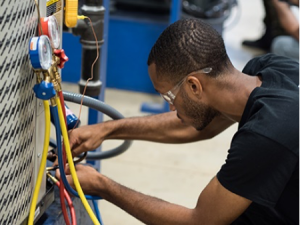
SDG&E: Is Your Business Wasting Energy?
( Source / SDG&E
Heating, ventilation and air conditioning (HVAC) consumes approximately 40% of a building’s electricity. In fact, it’s one of the most significant factors in the operating expenses of a business. That’s why it pays to pinpoint HVAC energy waste and reduce it. Here are 3 common HVAC waste areas and proven ways to help your business become more energy-efficient and control costs.
Blocked vents require up to 25% more energy to distribute air. Take a close look around your business. Are vents blocked by furniture, paper, tools or equipment? Those blocked vents are preventing vital airflow and making your system work harder to heat or cool your business. That’s unnecessary waste and it’s costing your business every month.
Solution: Clear air distribution is essential to contribute to energy efficiency. It’s also important for maintaining a good comfort level for your employees and customers. Carefully assess the area around each vent for proper ventilation. Is air flowing from the vent circulating freely throughout the room? If there are obstructions that prevent adequate airflow, such as cabinetry or drapes, move them to allow for clear circulation. Don’t keep vents closed as an effort to save energy; doing this can change the way air is distributed and cause an imbalance to the operation of the HVAC system. Remember to also check any vents on the floor. It can be more difficult to keep these areas clear of obstructions.
Up to 80% of energy can be recovered from exhaust air. Exhaust air from inefficient HVAC systems wastes a major opportunity for more efficient heating and cooling. That’s because more energy is required to heat or cool incoming outside air. But there are smart ways to prevent that waste.
Solution: Heat-recovery technology transfers energy from exhaust air to incoming outside air. This greatly reduces the energy that’s required to heat or cool incoming air. As a result, businesses can recover 50% to 80% of energy waste. It’s important to note the percentage of outside air that can be used for efficient ventilation is based on a few factors, including project scope, technology selection and design. A qualified contractor can educate customers on available recovery technologies. For example, an energy recovery ventilator (ERV) can be a suitable solution for maintaining comfortable temperature, depending on area location and climate. Businesses can turn to their HVAC contractor to decide if an ERV is appropriate. Heat-recovery technologies can include heat exchangers, recuperators, regenerators, passive air pre-heaters and waste heat boilers.
Advanced controls can reduce energy use by 40%. Ever feel cold when you’re in a big conference room or eating in the cafeteria with just a few other people? That may be because the ventilation system is running at maximum operating power, as if the room was at capacity. It is a huge waste of energy.
Solution: Installing advanced control sensors can improve a ventilation system’s operating power for energy efficiency. These controls can count the number of people in a room and then adjust the heat and air conditioning accordingly. When the sensors are integrated into a building’s HVAC system, the advanced controls can reduce energy use by almost 40%. That could save a typical 500,000-square-foot office building tens of thousands of dollars each year. Such buildings in the U.S. take up more than 4.4 billion square feet.
Take Advantage of No-Cost Training From Energy Experts
Learn new skills at your own pace. Did you know that SDG&E provides webinars for business owners and trade professionals, and most are at no cost? You or your employees can learn about the latest in green building practices, technology and energy-saving solutions from industry experts. Some of April’s topics include:
- Energy audit skills: tools, data collection techniques and calculations
- HVAC: cooling tower efficiency
- Full scale induction for commercial kitchens: cooktops and woks
- Title 24: residential modeling
- Heat pump water heater retrofit: energy cost estimator
Certifications and continuing education units are available for many of the classes. Check out the class listing at sdge.com/EIC.
